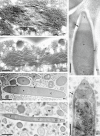Bacterial symbiosis in ciliates (Alveolata, Ciliophora): Roads traveled and those still to be taken
- PMID: 35006645
- PMCID: PMC9539572
- DOI: 10.1111/jeu.12886
Bacterial symbiosis in ciliates (Alveolata, Ciliophora): Roads traveled and those still to be taken
Abstract
The diversity of prokaryotic symbionts in Ciliophora and other protists is fascinatingly rich; they may even include some potentially pathogenic bacteria. In this review, we summarize currently available data on biodiversity and some morphological and biological peculiarities of prokaryotic symbionts mainly within the genera Paramecium and Euplotes. Another direction of ciliate symbiology, neglected for a long time and now re-discovered, is the study of epibionts of ciliates. This promises a variety of interesting outcomes. Last, but not least, we stress the new technologies, such as next generation sequencing and the use of genomics data, which all can clarify many new aspects of relevance. For this reason, a brief overview of achievements in genomic studies on ciliate's symbionts is provided. Summing up the results of numerous scientific contributions, we systematically update current knowledge and outline the prospects as to how symbiology of Ciliophora may develop in the near future.
Keywords: Euplotes; Holospora; Paramecium; Ciliophora; Holospora-like bacteria; endosymbiosis; episymbiosis; morphology; phylogeny; symbionts.
© 2022 The Authors. Journal of Eukaryotic Microbiology published by Wiley Periodicals LLC on behalf of International Society of Protistologists.
Figures


Similar articles
-
Frequency and biodiversity of symbionts in representatives of the main classes of Ciliophora.Eur J Protistol. 2012 May;48(2):138-48. doi: 10.1016/j.ejop.2011.12.001. Epub 2012 Mar 16. Eur J Protistol. 2012. PMID: 22425549
-
Bacterial endocytobionts of ciliophora and their interactions with the host cell.Int Rev Cytol. 2004;236:181-249. doi: 10.1016/S0074-7696(04)36005-5. Int Rev Cytol. 2004. PMID: 15261739 Review.
-
Morphological diversity and molecular phylogeny of five Paramecium bursaria (Alveolata, Ciliophora, Oligohymenophorea) syngens and the identification of their green algal endosymbionts.Sci Rep. 2022 Oct 27;12(1):18089. doi: 10.1038/s41598-022-22284-z. Sci Rep. 2022. PMID: 36302793 Free PMC article.
-
Symbiont replacement between bacteria of different classes reveals additional layers of complexity in the evolution of symbiosis in the ciliate Euplotes.Protist. 2018 Feb;169(1):43-52. doi: 10.1016/j.protis.2017.12.003. Epub 2017 Dec 20. Protist. 2018. PMID: 29414319
-
Anaerobic ciliates as a model group for studying symbioses in oxygen-depleted environments.J Eukaryot Microbiol. 2022 Sep;69(5):e12912. doi: 10.1111/jeu.12912. Epub 2022 May 3. J Eukaryot Microbiol. 2022. PMID: 35325496 Review.
Cited by
-
An Evolutionary-Focused Review of the Holosporales (Alphaproteobacteria): Diversity, Host Interactions, and Taxonomic Re-ranking as Holosporineae Subord. Nov.Microb Ecol. 2025 Mar 14;88(1):15. doi: 10.1007/s00248-025-02509-0. Microb Ecol. 2025. PMID: 40085262 Free PMC article. Review.
-
Methanogenic symbionts of anaerobic ciliates are host and habitat specific.ISME J. 2024 Jan 8;18(1):wrae164. doi: 10.1093/ismejo/wrae164. ISME J. 2024. PMID: 39163261 Free PMC article.
-
Culture-Independent Single-Cell PacBio Sequencing Reveals Epibiotic Variovorax and Nucleus Associated Mycoplasma in the Microbiome of the Marine Benthic Protist Geleia sp. YT (Ciliophora, Karyorelictea).Microorganisms. 2023 Jun 5;11(6):1500. doi: 10.3390/microorganisms11061500. Microorganisms. 2023. PMID: 37375002 Free PMC article.
-
Cellular interactions and evolutionary origins of endosymbiotic relationships with ciliates.ISME J. 2024 Jan 8;18(1):wrae117. doi: 10.1093/ismejo/wrae117. ISME J. 2024. PMID: 38916437 Free PMC article. Review.
-
A 63-kDa Periplasmic Protein of the Endonuclear Symbiotic Bacterium Holospora obtusa Secreted to the Outside of the Bacterium during the Early Infection Process Binds Weakly to the Macronuclear DNA of the Host Paramecium caudatum.Microorganisms. 2023 Jan 7;11(1):155. doi: 10.3390/microorganisms11010155. Microorganisms. 2023. PMID: 36677447 Free PMC article.
References
-
- Beliavskaia, A.Y. , Predeus, F.V. , Garushyants, S.K. , Logacheva, M.D. , Gong, J. , Zou, S. et al. (2020) New intranuclear symbiotic bacteria from macronucleus of Paramecium putrinum—Candidatus Gortzia yakutica. Diversity, 12, 198. 10.3390/d12050198 - DOI
-
- Boscaro, V. , Felletti, M. , Vannini, C. , Ackerman, M.S. , Chain, P.S. , Malfatti, S. et al. (2013) Polynucleobacter necessarius, a model for genome reduction in both free‐living and symbiotic bacteria. Proceedings of the National Academy of Sciences of the United States of America, 110, 18590–18595. - PMC - PubMed
-
- Boscaro, V. , Fokin, S.I. , Schrallhammer, M. , Schweikert, M. & Petroni, G. (2013) Revised systematic of Holospora‐like bacteria and characterization of “Candidatus Gortzia infectiva”, a novel macronuclear symbiont of Paramecium jenningsi . Microbial Ecology, 65, 255–267. - PubMed
-
- Boscaro, V. , Kolisko, M. , Felletti, M. , Vannini, C. , Lynn, D.H. & Keeling, P.J. (2017) Parallel genome reduction in symbionts descended from closely related free‐living bacteria. Nature Ecology & Evolution, 1, 1160–1167. - PubMed
Publication types
MeSH terms
Grants and funding
LinkOut - more resources
Full Text Sources

